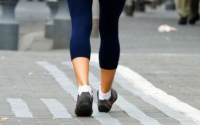CAN YOU REBUILD YOUR CARTILAGE AND REDUCE OSTEOARTHRITIS?
Every year more than 10 million adults (6 million women and 4 million men) consult their GP with arthritis and related conditions.
Osteoarthritis is the most common form of arthritis. It usually develops gradually, over time. Several different joints can be affected, but osteoarthritis is most frequently seen in the hands, knees, hips, feet and spine. It is estimated that osteoarthritis causes joint pain in 8.5 million people in the UK (1in every 7 people).
Osteoarthritis cannot be cured and there is no known cause. Studies have shown that it is more common among women and although osteoarthritis can develop at any age, it occurs more frequently in older people. Injury to a joint can also trigger osteoarthritis, even many years later.
A recent study from ScienceDaily (Aug. 2, 2010) found that although women have been wearing trendy stilettos, wedges, pumps and kitten heels for many year, there is now growing concern about what those heels may be doing to their knees and joints over time.
A new study by an Iowa State University kinesiology master’s student has found that prolonged wearing of and walking in high heels can contribute to joint degeneration and knee osteoarthritis.
Danielle Barkema, the ISU student who is originally from Cedar Falls, recently completed her thesis research studying the effects of high-heeled walking on forces acting on lower extremity joints. Kinesiology professor and department chair Phil Martin assisted her in the study,
“Obviously with research like this, you can’t say with any certainty that if you wear high heels regularly you will develop osteoarthritis. We don’t know that,” Barkema said. “There are probably people [high heel wearers] who do and those who do not. However, based on this information, wearing high heels puts individuals at greater risk for developing osteoarthritis. And it seems to be that the higher the heel height, the greater the risk.”
Testing three heel heights
Barkema selected three different heel heights — flat, two inches, and 3.5 inches– and had each of the 15 women in her study complete walking trials. She measured the forces acting about the knee joint and the heel-strike-induced shock wave that travels up the body when walking in heels. Using sensors, accelerometers and lab equipment such as a force platform and markers/cameras, she was able to capture motion and force data and translate them into results that could change the way millions of women select their footwear.
While previous studies have examined the effect of high heels on joints, the ISU researchers found that heel height changes walking characteristics such as slower speeds and shorter stride lengths. And as the heels got higher, they also saw an increase in the compression on the inside – or medial side – of the knee.
“This means that prolonged wearing and walking in heels could, over time, contribute to joint degeneration and knee osteoarthritis,” Barkema said.
Osteoarthritis – Women vs Men
Women have osteoarthritis, the most common form of arthritis, at much higher rates than men. Before age 55, more men tend to have osteoarthritis, but after age 55 the number of women with the condition far surpasses the number of men.
Joints affected by osteoarthritis also tend to vary by gender, says Alexander Shikhman, MD, PhD, founder of the Institute for Specialized Medicine in Del Mar, California, and medical director of Restorative Remedies. Men are more prone to experience arthritis in their hips, while women tend to have it in the knees or hands, he says. There are several reasons why these differences occur. They include;
Biology
Women’s bodies are designed to give birth, and that means the tendons in their lower body are more elastic than men’s. “As a result, the joints probably move around a little more,” says Yusuf Yazici, MD, a rheumatologist at New York University Hospital for Joint Diseases in New York. When the joints have less stability, they’re more prone to injury.
Women’s hips are wider than their knees, their knee joints are not aligned as straight as men’s Dr. Yazici says. The alignment of a woman’s body leads to a higher rate of knee injuries, and injuries can lead to osteoarthritis later in life.
Experts have found that women who play soccer, for instance, have at least three to four times the number of knee injuries as men who play soccer.
Genetics
Osteoarthritis seems to run in families, and there appears in particular to be a genetic link among women. Women whose mothers developed osteoarthritis will probably find that they will develop it in the same joints at around the same age as she did, Yazici says. Researchers have found that hand and knee osteoarthritis have specific genetic links.
Hormones
Researchers believe that female hormones have an effect on the cartilage that sits between the bones of the joints and cushions the bones to prevent pain and allow the joints to move about smoothly. In laboratory studies of cells that form cartilage, experts have found that the female hormone estrogen protects cartilage from inflammation, Dr. Shikhman says.
Inflammation can lead to osteoarthritis. But after menopause, when women’s estrogen levels go down, they lose that protection and may have a higher risk of developing osteoarthritis even if they are on hormone-replacement therapy (HRT).
Treatment for Osteoarthritis;
Flexeze Fortify™ is the first product that helps support the natural regeneration of joint cartilage. Whereas Glucosamine is thought to slow down the effects of joint wear and tear, Flexeze Fortify™ actually helps reverse the process.
Put simply – it is a joints supplement which actually helps rebuild and repair cartilage, usually damaged by wear and tear or osteoarthritis. It contains an award-winning ingredient* called Fortigel that is made up of a patented collagen hydrolysate. Fortigel helps build up Collagen which is the key component of cartilage.
Yoga is also widely used to ease the symptoms of osteoarthritis. Yoga’s gentle movements can keep build strength, flexibility, and balance and reduce arthritis pain and stiffness. A pilot study conducted by the University of Pennsylvania School of Medicine examined one type of yoga, Iyengar yoga, for people with osteoarthritis of the knee. After an 8-week course of weekly 90-minute beginner classes, there was a statistically significant reduction in pain, physical function, and mood.
More recently – a brand new survey, conducted by Vivo Healthcare with 500 women found the following;
42% of women over 50 missed at least one yoga session in the last year through joint pain
27% of women over 50 missed 4 or more yoga sessions in the last year through joint pain
54% of women questioned felt joint pain inhibited their ability to exercise to their full potential
Scientific Evidence that Flexeze Fortify™ works;
A double-blind, placebo-controlled study, jointly undertaken in America by Harvard Medical School and Tufts Medical centre in Boston evaluated patients over the age of 48 with arthritis of the knee.
The 30 patients were divided into two groups, a control group and a study group. Half of them took collagen hydrolysate and the other group a placebo. The MRI scans taken after one week, 24 weeks and 48 weeks, showed patients had significant re-growth of damaged cartilage.
The year-long trial reported that while the cartilage in the placebo group deteriorated over the weeks, the groups taking the supplement collagen hydrolysate (Flexeze Fortify™) experienced regeneration in cartilage.
The cell-study results compliment those of researchers at the Kiel- based Collagen Research Institute who reported to the congress of the Osteoarthritis Research Society International (ORSI) in Montreal.
They noted that the bioactive collagen peptides formulation in Flexeze, were found to stimulate cell metabolism in knee-joint cartilage and promote the regeneration of cartilage tissue.
Dr Andrew Carson, a GP who is Associate Dean, GP Education, Birmingham and Solihull and Medical Advisor to the NHS Executive in the West Midlands said;
“These two studies show real promise. I am not aware of any other product which has been shown to regenerate articular cartilage. The best that other products have achieved in the past is a reduction in the speed of disease progression and a subjective improvement in pain sensation. The improvements seen in the growth of the articular cartilage in the study group achieved statistical significance. I would recommend anyone taking glucosamine and chondroitin to consider this option which is a natural product with no known side-effects.”
For further information on Flexeze visit: http://www.flexeze.co.uk
About the Author: Chantal Cooke is an award winning journalist.


